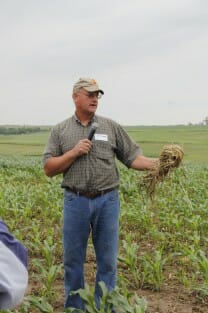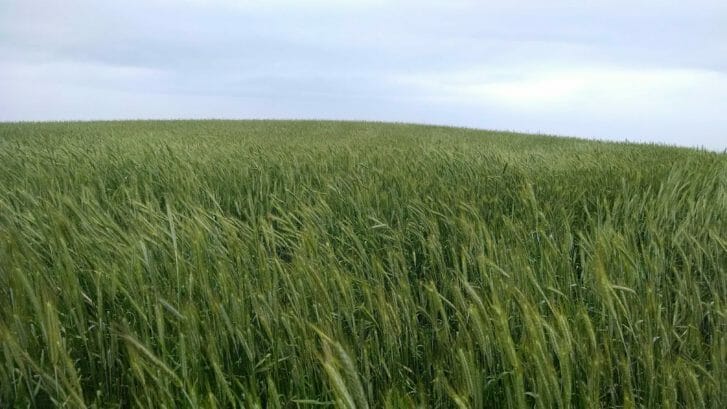Green Iron Farms Field Day: Winter Cereal Rye for Cover and Cash Grain

Tim Sieren (far right with microphone) addresses the crowd at the field day at his family’s farm, Green Iron Farms.
The Sieren Family—Tim; his wife, Ethel; his father, Denny; his daughter, Nicole Strand; and numerous grandchildren (4 generations!)—hosted over 60 people on their farm, Green Iron Farms, near Keota for a Practical Farmers of Iowa field day on June 10. Tim currently farms the land his father, Denny, used to farm. Tim and Denny explained to us that they converted the farm to no-till back in 1980 and were among the earliest in the area to do so. “We live in an ever-changing world and agriculture is no different,” Denny explained as he came to the decision years ago to go no-till as a soil conservation measure. “Some folks, though, are just set in their ways,” Tim added.
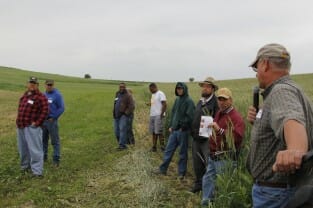
Tim explains to the group why he likes cereal rye as a grain crop and a cover crop as a valuable soil conservation practice in his cropping systems.
Tim has continued the tradition of soil conservation on the farm as an early adopter of cover crops, growing cereal rye between plantings of corn and soybeans. Green Iron Farms is set in a beautiful rolling rural landscape between the English and Skunk Rivers. This rolling land consists of a lot of C and D slopes (15-30% slopes) that can make soil conservation a challenge, Tim explained to the group. He has been very satisfied with the success of the cereal rye he drills or broadcasts after corn or soybean harvest. The rye doesn’t always put on much fall growth, but Tim said that if you allow the rye to get 6-8 inches tall in the next spring before planting corn or soybean, that’s when one really sees the soil-holding ability to withstand hard spring rains. “If you only let the rye get 2-3 inches tall and then kill it to plant corn, you won’t get any benefit out of the rye. A lot of guys just want to plant corn as early as possible and they’re not going to utilize the rye to its full potential.”
When Tim first started using cover crops, he was purchasing cereal rye seed from his local seed dealer. Tim’s previous experience with growing small grains like wheat and oats, however, got him to thinking about raising his own cover crop seed. Three years ago, he planted his first crop of winter cereal rye and has continued to do so. Tim saves much of the seed he raises to grow the following year’s crop AND to use as a cover crop on his corn and soybeans acres.
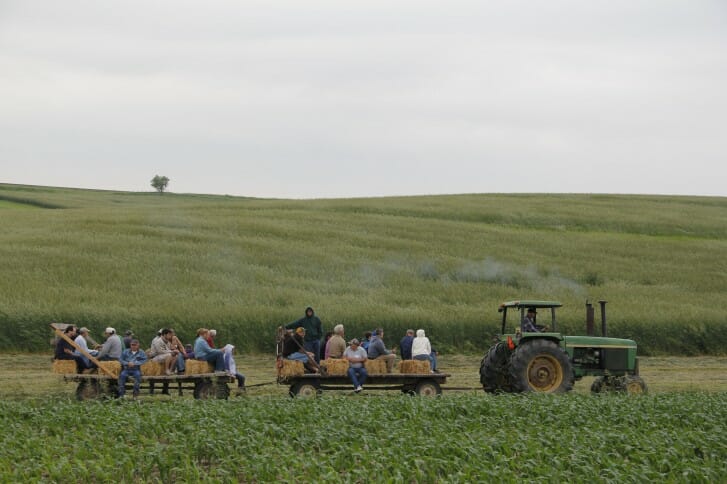
Taking a ride on hay racks in the field at Green Iron Farms. Cereal rye on the hill in the background.
The group got to take a ride out to the rye field with Denny driving the tractor and Tim riding on the hay racks and conversing with the crowd about his production practices. It was a breezy day and we could see waves ripple through the shoulder-high rye on the hillside (see video below). Tim addressed some of the heavy rain events this spring while regarding the tall, lush rye crop, “I don’t care how much rain will fall on that cereal rye; that soil on that hill under the canopy won’t wash away.” This harkened back to Tim’s statement about allowing the rye to get tall enough to “do its job” and hold the soil in place.
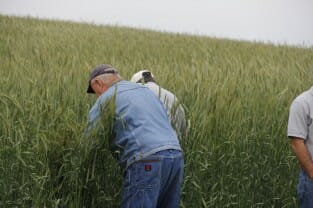
Field day attendees having a look at Tim Sieren’s shoulder-high cereal rye crop. Tim will harvest this rye for seed in July.
Rye that is allowed to mature and go to seed will grow vigorously in May and June, a time in Iowa when we really can experience some heavy downpours. Harvest occurs in mid-July and Tim explained that he keeps the seed in a wagon for a few months before planting it in the fall. “I’ve sent the seed in to be tested and I generally get an 85% germination rate.” Tim also stressed that getting the seed cleaned is essential for a successful planting in the fall if one is planning on drilling but not as necessary if one is broadcasting with a seed spreader.
In addition to raising cereal rye for seed, Tim also raises some as forage for his small cattle herd. About two weeks ago, Tim cut some rye, raked and bailed it, and then bagged it. He’ll let the rye sit in the bags for 45 days allowing it to “ensile” before feeding it to his cattle. Tim explained that he doesn’t run a lot of pasture land so this rye silage acts as a nice feed source and that the cattle really seem to enjoy it. Soon after cutting and removing the rye residue, Tim drilled soybeans as part of a double-crop sequence. The beans were at the 5-6 leaf stage at the field day and Tim was anticipating a decent crop this fall.
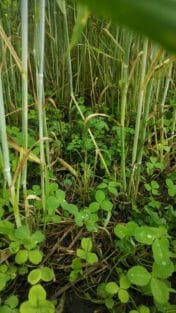
Red clover growing beneath the cereal rye canopy. The clover will go on to “feed” next year’s corn crop.
But how well does rye fit into a crop rotation in Iowa? To answer this question, Tim got involved with an on-farm research trial as part of Practical Farmers of Iowa’s Cooperators’ Program. Last April, Tim drilled red clover in strips into the cereal rye just as the rye was beginning to green up. After the rye was harvested last July, the clover in the strips took off and grew a lush, green carpet before going dormant in the winter. This spring, Tim terminated the red clover and no-tilled corn into the dying mulch. The objective of the trial is to determine how well the corn will perform after the rye+clover companion crop; how much N fertilizer can be replaced by the red clover green manure? The results of this trial will be part of a research report due out this fall after corn harvest. Be sure to look for the report on our website!
At the end of the field day, Tim wanted the crowd to understand the benefits of cereal rye on his farm as the Sieren family continues their tradition of soil conservation at Green Iron Farms. Rye can be used in a multitude of ways—cover, forage, seed—all towards the end of soil conservation. Tim left us with some parting words of wisdom: “When soil erosion becomes a passing fad, that’s when cover crops will have become a passing fad.”

